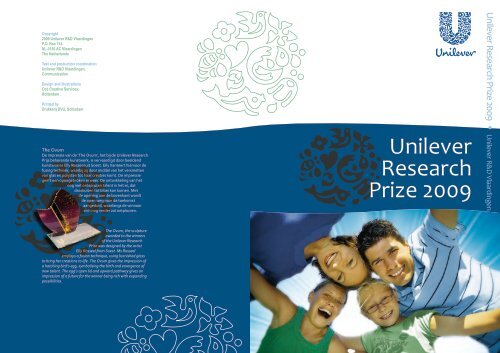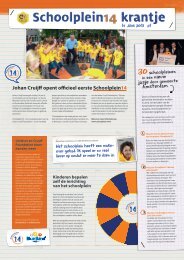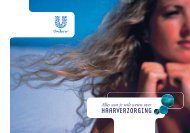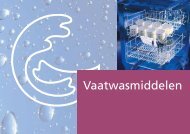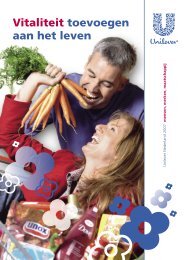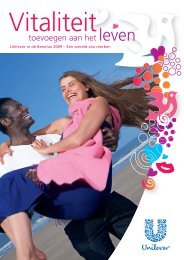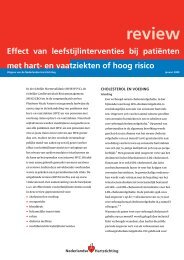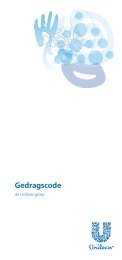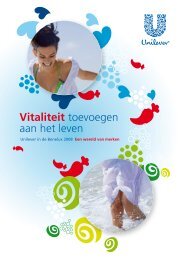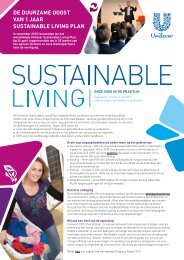Unilever Research Prize 2009
Unilever Research Prize 2009
Unilever Research Prize 2009
You also want an ePaper? Increase the reach of your titles
YUMPU automatically turns print PDFs into web optimized ePapers that Google loves.
Copyright<br />
<strong>2009</strong> <strong>Unilever</strong> R&D Vlaardingen<br />
P.O. Box 114<br />
NL-3130 AC Vlaardingen<br />
The Netherlands<br />
Text and production coordination<br />
<strong>Unilever</strong> R&D Vlaardingen,<br />
Communication<br />
Design and illustrations<br />
Océ Creative Services,<br />
Rotterdam<br />
Printed by<br />
Drukkerij DVU, Schiedam<br />
The Ovum<br />
De impressie van de ‘The Ovum’, het bij de <strong>Unilever</strong> <strong>Research</strong><br />
Prijs behorende kunstwerk, is vervaardigd door beeldend<br />
kunstenares Elly Rosseel uit Soest. Elly hanteert hiervoor de<br />
fusing techniek, waarbij zij door middel van het versmelten<br />
van glas en polijsten tot haar creaties komt. De impressie<br />
geeft een opengebroken ei weer. De ontwikkeling van het<br />
nog niet ontsproten talent in het ei, dat<br />
daarbuiten tot bloei kan komen. Met<br />
de opening aan de bovenkant wordt<br />
de open weg naar de toekomst<br />
aangeduid, waarlangs de winnaar<br />
zich nog verder zal ontplooien.<br />
The Ovum, the sculpture<br />
awarded to the winners<br />
of the <strong>Unilever</strong> <strong>Research</strong><br />
<strong>Prize</strong> was designed by the artist<br />
Elly Rosseel from Soest. Ms Rosseel<br />
employs a fusion technique, using burnished glass<br />
to bring her creations to life. The Ovum gives the impression of<br />
a hatching bird’s egg, symbolising the birth and emergence of<br />
new talent. The egg’s open lid and upward pathway gives an<br />
impression of a future for the winner being rich with expanding<br />
possibilities.<br />
<strong>Unilever</strong><br />
<strong>Research</strong><br />
<strong>Prize</strong> <strong>2009</strong><br />
A4-URP Programma <strong>2009</strong>.indd 1-2 01-12-<strong>2009</strong> 17:43:09<br />
<strong>Unilever</strong> <strong>Research</strong> <strong>Prize</strong> <strong>2009</strong> • <strong>Unilever</strong> R&D Vlaardingen
Introduction<br />
In our centres researchers work daily on the<br />
shaping of new innovations, which are crucial<br />
for <strong>Unilever</strong>’s Growth Agenda. Moreover,<br />
connections with the outer world, including<br />
scientists from the academic institutes, are<br />
crucial in identifying and exploring the potential<br />
of new discoveries for our business.<br />
Part of our relationship with the academic world<br />
is the granting of the <strong>Unilever</strong> <strong>Research</strong> <strong>Prize</strong>.<br />
The annual <strong>Prize</strong> Award is a tradition that is as<br />
old as our R&D centre in Vlaardingen. This means<br />
that the <strong>2009</strong> edition is the 53rd time that Dutch<br />
universities have nominated Master of Science<br />
graduates from a variety of disciplines relevant<br />
for <strong>Unilever</strong> <strong>Research</strong> & Development.<br />
The <strong>Research</strong> <strong>Prize</strong> also shows our appreciation<br />
of the outstanding work of talented Master of<br />
Science students. This year all of the 14 winners<br />
are young academics who have conducted<br />
important research in the fields of chemistry,<br />
biotechnology, mechanical engineering, biology,<br />
agricultural science and social sciences. Through<br />
granting research prizes <strong>Unilever</strong> wishes to<br />
stimulate these promising talents in their future<br />
development.<br />
The quality of the contributions again is<br />
of a high standard. <strong>Unilever</strong> would like to<br />
congratulate all of the winners and pay<br />
compliments to the participating universities<br />
for submitting these promising nominations.<br />
Dr. John Verbakel<br />
Director <strong>Unilever</strong> R&D<br />
Vlaardingen<br />
Meeting<br />
everyday needs<br />
<strong>Unilever</strong> is the world’s second-largest consumer<br />
goods company. Our mission is to add vitality to life<br />
by meeting everyday needs for nutrition, hygiene<br />
and personal care with brands that help people feel<br />
good, look good and get more out of life.<br />
Our CEO Paul Polman recently restated his ambition<br />
for innovation in <strong>Unilever</strong>: it will be the main driver<br />
of future sales and profit growth. Over the last<br />
couple of years, <strong>Unilever</strong> R&D has been transformed<br />
to deliver more competitive advantage in line with<br />
this ambition:<br />
•<br />
•<br />
•<br />
•<br />
•<br />
•<br />
•<br />
Geneviève Berger has been appointed Chief<br />
R&D Officer, full member of <strong>Unilever</strong>’s Executive<br />
board.<br />
The 3 global R&D organisations (Foods R&D,<br />
HPC R&D and Corporate <strong>Research</strong>) have been<br />
integrated into One <strong>Unilever</strong> R&D.<br />
Global research has been focused in 6 strategic<br />
centres based in the Netherlands, the U.K., the<br />
U.S., India and China.<br />
Global product development has been focused in<br />
13 centres around the world.<br />
Regional, country and factory implementation<br />
teams ensure full and fast roll-out to all markets.<br />
One global R&D programme has been defined<br />
across categories and regions – global research,<br />
product development and regional / local<br />
implementation deliver this programme in crossfunctional<br />
teams.<br />
<strong>Unilever</strong> now employs more than 6000<br />
employees worldwide, including 1500 scientists,<br />
with a total budget of more than 900 million<br />
euros per year.<br />
Explaining<br />
URDV<br />
<strong>Unilever</strong> <strong>Research</strong> &<br />
Development Vlaardingen<br />
For over fifty years Vlaardingen R&D<br />
has contributed to the <strong>Unilever</strong> product<br />
portfolio by continuously improving<br />
existing products and launching new<br />
ones. For example: Small & Mighty, double<br />
concentrated liquid detergents; Sun<br />
Green, environmentally friendly machine<br />
dish wash tablets; Becel's Heart Age Tool,<br />
an online tool that calculates how old/<br />
young your heart is, compared to your<br />
chronological age; Calve’s Extra Light<br />
Mayonnaise with citrus fibre technology;<br />
Lipton Linea Tea, with catechins; Becel Pro<br />
Activ Bloodpressure margarine and fruit<br />
shots with potassium – good for blood<br />
pressure, and advancements in behindthe-scenes<br />
work, like microbiological<br />
safety; all researched and co-developed<br />
by Vlaardingen-based scientists and<br />
technologists.<br />
The R&D facility in Vlaardingen employs<br />
more than 1,050 people, of more than 40<br />
nationalities, working in multidisciplinary<br />
project teams with clear business targets.<br />
<strong>Unilever</strong> R&D Vlaardingen is organised to<br />
add to <strong>Unilever</strong>’s innovative capability across<br />
three pillars:<br />
•<br />
<strong>Research</strong>: Delivering differentiated and<br />
protected new product technology<br />
for innovation. Vlaardingen hosts a<br />
number of global research expertise<br />
fields: Structured Materials and Process<br />
Science; Nutrition and Health; Sensation,<br />
Perception and Behaviour; Advanced<br />
Measurement and Data Modelling.<br />
•<br />
•<br />
Global Product Development:<br />
Turning a discovery from research<br />
(a new technology, ingredient or insight)<br />
into a new product for global roll-out.<br />
Vlaardingen hosts the global product<br />
development centre for Structured<br />
Emulsions and Laundry.<br />
Regional development and<br />
implementation: Bringing new<br />
innovations to local markets and<br />
constantly renewing existing products<br />
for better value. Vlaardingen hosts<br />
the regional development centres for<br />
Structured Emulsions, Laundry and<br />
Machine Dishwash.<br />
Partnerships and sustainability<br />
<strong>Unilever</strong> has a long and established interest<br />
in developing and emerging markets, where<br />
our products can have a major impact on<br />
nutrition, hygiene and quality of life. We<br />
work with organisations like UNICEF, the<br />
World Food Programme and the World<br />
Heart Federation to combat poor nutrition<br />
in both the developing and the developed<br />
world.<br />
Climate change and water<br />
scarcity are also some of the<br />
big challenges facing the<br />
world and our business<br />
today. In September<br />
<strong>2009</strong> <strong>Unilever</strong><br />
introduced its Cleaner<br />
Planet Plan, a worldwide<br />
sustainability<br />
programme with the<br />
aim to save on water,<br />
waste, CO2 emissions and<br />
environmentally harmful<br />
commodities. �<br />
A4-URP Programma <strong>2009</strong>.indd 3-4 01-12-<strong>2009</strong> 17:43:28
3)<br />
The Story behind Sun Green Power<br />
SUN’s<br />
Efficacy<br />
<strong>Unilever</strong> first introduced machine dish wash (MDW) detergents in the 1960’s under the Sun brand.<br />
Since then Sun has grown to become an important player in this market during its history of continuous<br />
innovation.<br />
Dishwashers are a familiar feature of many homes nowadays. Consumers buy a dishwasher primarily for<br />
convenience. They expect perfect cleaning results and, of course, their dishes should not be damaged<br />
by the process.<br />
Recently, awareness of the environmental impact of household activities including machine dishwashing<br />
has increased. Machine manufacturers have designed models that use less water and energy. At the<br />
same time, <strong>Unilever</strong> and other major detergent manufacturers have developed products capable of<br />
excellent results at 50 degree Celsius wash cycles. In addition, they are encouraging the consumer to be<br />
ecologically friendly under the ‘Save Energy and Water‘ campaign of the international Association for<br />
Soaps, Detergents and Maintenance (AISE). When these guidelines are followed, machine dishwashing<br />
can compare favourably with dishwashing by hand in terms of energy and water usage.<br />
The next logical step in responding to the increasing consumer awareness is the development of a range<br />
of detergents with reduced use of chemical and packaging materials, whilst retaining the excellent<br />
results in low temperature wash cycles. Such an innovation also contributes to <strong>Unilever</strong>’s Vitality<br />
strategic thrust – Less Environmental Impact<br />
• The LCA assessment covers the majority of the life cycle from<br />
cradle to grave. Commonly used, it is recognized as the fairest<br />
way to evaluate te environmental profile of a product.<br />
Raw material and energy consumption<br />
Fabrication Steps Retail Consumer Use End of Life<br />
Emissions to air, water and land<br />
A key technical challenge in this<br />
project was to find a replacement<br />
for sodium tripolyphosphate<br />
(STTP) which is a major ingredient<br />
in current products. Whilst STTP<br />
is a safe and highly effective water<br />
softener, it makes a relatively<br />
large contribution to the overall<br />
environmental impact of the<br />
formulation.<br />
Around 30 alternative water<br />
softeners were screened in this<br />
project against criteria including<br />
wash performance, human and<br />
environmental safety, availability,<br />
1)<br />
goes Green<br />
by Tim Price<br />
cost and processing. A strong contender emerging from this exercise was Methylglycine diacetate,<br />
sodium salt (MGDA). MGDA is a commercially available strong sequestrant and is considerably more<br />
effective by weight than STTP.<br />
In order to apply this material in dishwasher detergent tablets two technical problems had to be<br />
solved. Firstly, MGDA used on its own can lead to unacceptable corrosion and fading of glass items.<br />
This problem has been solved by the use of soluble Bismuth salts. Bismuth ions interact with the glass<br />
surface and prevent the selective dissolution which leads to corrosion and fading 1).<br />
The second problem in applying MGDA arises from the hygroscopicity of the powdered material.<br />
This makes it very difficult to use in a tabletting process and the resultant tablets absorb water rapidly,<br />
and disintegrate. A new process has been developed which produces granules containing hydrated<br />
MGDA which are stable and can easily be processed into tablets<br />
2).<br />
The new formulations containing these technologies have been<br />
shown to fully match the performance of traditional products and<br />
allow very significant savings in chemicals (18%) and packaging<br />
(20%) because of the improved weight effectiveness of MGDA.<br />
A full Life Cycle Assessment ( LCA) has been carried out for<br />
Sun Green Power. This shows a significant reduction in global<br />
warming potential, eutrophication and energy use compared to<br />
current market standards.<br />
Consumers’ reactions to Sun Green Power have been positive and<br />
independent tests by consumer organisations have confirmed<br />
that the product delivers fully on performance, unlike the existing<br />
eco brands available.<br />
Sun will continue to innovate in sustainable machine dish wash<br />
products in line with the recently announced ‘Cleaner Planet<br />
plan’, <strong>Unilever</strong>’s way of helping consumers to continue achieving<br />
outstanding results with products that enable them to reduce the<br />
impact of laundry on the environment. �<br />
Less water<br />
Minimising water used in irrigation of raw<br />
materials, amount of water in the<br />
formulation, and the amount of water<br />
recommended per consumer use.<br />
Less waste<br />
Create less packaging wast through<br />
new materials<br />
Incentivising reuse/recycle/recovery<br />
Minimising our packaging wast and product<br />
leftovers, through design/new formats<br />
Less greenhouse gases<br />
Accross the total product lifecycle<br />
Increase the use of<br />
sustainable resources<br />
Notes:<br />
1. PATENT: EP1721962<br />
2. PATENT: EP<strong>2009</strong>/053781<br />
A4-URP Programma <strong>2009</strong>.indd 5-6 01-12-<strong>2009</strong> 17:43:35<br />
2)
Sustainability:<br />
Sustainability is often incorporated into business as an effort to mitigate the impacts; on health,<br />
environment, communities and so on. This is a valuable process. But also limiting. The approach<br />
takes the present reality as a baseline and tries to reduce its negative impact. You can also see<br />
sustainability as an opportunity, an expanded space. There are new business concepts to be<br />
invented, new needs to be met.<br />
One way of describing the expanded space is to look at the way that marketing meets needs. The<br />
concept of needs is also central to that of sustainability. Here is a quote from one of the original<br />
definitions, from the UN’s Bruntland Commission report, Our Common Future:<br />
"Sustainable development is development that meets the needs of the present without<br />
compromising the ability of future generations to meet their own needs. It contains within it two key<br />
concepts:<br />
• the concept of 'needs', in particular the essential needs of the world's poor, to which overriding<br />
priority should be given; and<br />
•<br />
An Innovation<br />
Opportunity<br />
By John Grant<br />
the idea of limitations imposed by the state of technology and social organisation on the<br />
environment's ability to meet present and future needs."<br />
<strong>Unilever</strong> is very familiar as an organisation with the concept of meeting such needs. The company<br />
was founded by Lord Leverhume with a strong focus on both creating a model society (Port Sunlight<br />
and its amenities were in some ways an anticipation of the welfare state) and also a pioneering<br />
interest in the role of soap, hygiene and cleanliness in improving health<br />
of the poor; a legacy which <strong>Unilever</strong> continues today in its promotion<br />
PEOPLE of hygiene in India with the Lifebuoy brand. <strong>Unilever</strong> was always also<br />
an innovative company when it came to its products, the original<br />
Sunlight soap having superior properties in use due to its formulation<br />
using mostly vegetable oils such as palm oil rather than tallow<br />
(animal fats).<br />
The concept of sustainability is sometimes summarized as one of<br />
meeting the needs of people, planet and profit. This gives us<br />
a handle on how the space is expanded today. For the past<br />
one hundred years marketing has concentrated primarily<br />
on the people-profit line; meeting people’s needs at a<br />
profit. Adding planet creates an expanded space for<br />
innovation, represented by a triangle.<br />
PLANET PROFIT<br />
It is often the case that new innovations come to light by<br />
considering a simple coincidence of these three needs:<br />
a win:win:win. One that emerged in the course of my<br />
innovation work with a mobile phone operator was the idea of<br />
3 or 4 year phone contracts. This is an advantage for the planet<br />
since fewer handsets being produced would lessen the impact on<br />
both resource depletion and waste. It would allow the engineers<br />
to concentrate efforts on a device that was built to last – with<br />
better specification within a much better total cost of ownership.<br />
For profit, and remember here we are discussing a mobile operator<br />
and not a handset manufacturer, such a contract would have huge<br />
benefits too; most of their costs are due to ‘churn’ (customers<br />
coming up for renewal at frequent intervals) and associated<br />
marketing costs. The cost of bundling a free handset with every<br />
contract was itself not insignificant. Overall my client calculated<br />
that they could afford with a longterm contract to charge 1/2 to<br />
2/3 of the current call rates, and would still make more profit.<br />
An attractive business model. The catch is how to make this<br />
appealing to people? If you talk to young people (for instance in<br />
focus groups) they will tell you that effectively mobile phones are<br />
the “new trainers” – a key signifier of being cool and with it. The<br />
current success of the iPhone is a case in point (although it has<br />
substantial functional benefits too – many previous trendy phones<br />
were based more on a cool “format” or even a colour). So you<br />
would have to make this the “Toyota Prius” of phones. Something<br />
which a significant segment of ethical consumers could brandish<br />
when people showed off the latest model and say “No thanks I am<br />
sticking with my green phone!” That’s a demonstration of working<br />
in the expanded space.<br />
In my presentation to the <strong>Unilever</strong> R&D day I will discuss a<br />
number of examples where “win:win:win” thinking has created<br />
breakthrough innovations.<br />
In many ways this line of thinking is where business strategy and<br />
innovation had already got to: for instance management guru Gary<br />
Hamel’s idea of “business concept engineering” and his claim that<br />
successful businesses should have a “cause” not just a strategy.<br />
But we have also in the last decade greatly expanded our<br />
evaluation of the responsibility of business. Prahalad’s latest<br />
book “The New Age of Innovation” touches on a key driver of<br />
expansive thinking which is the age of networks, leading to open<br />
innovation. �<br />
A4-URP Programma <strong>2009</strong>.indd 7-8 01-12-<strong>2009</strong> 17:43:37


